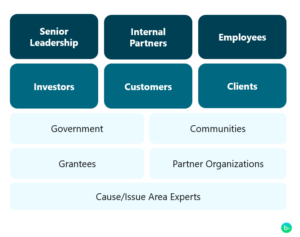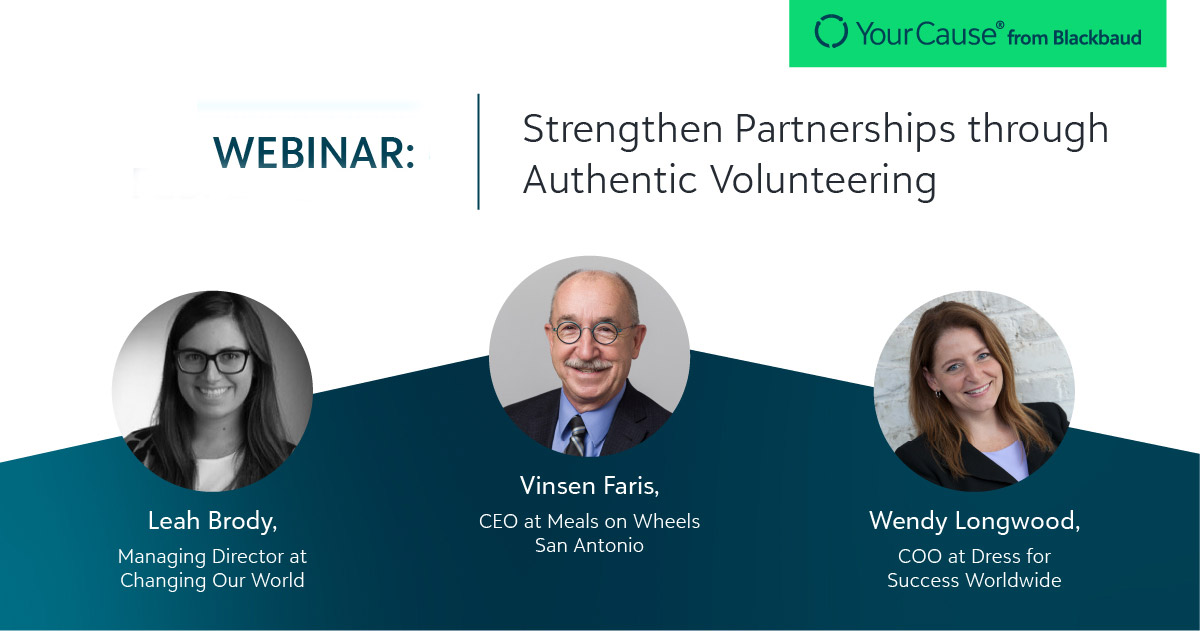Authors: Leah Brody, Senior Managing Director, Changing Our World, and
Jewell Willett, Senior Manager, Corporate Impact Customer Success, Blackbaud
Understanding Stakeholder Engagement
Have you ever volunteered in a way that didn’t seem to be meeting an actual need in the community? Or perhaps you’ve been tasked with facilitating a volunteer activity that’s been met with disinterest from your employee base. If you’re familiar with scenarios such as these, chances are you’ve encountered a volunteer program designed without stakeholder engagement.
Stakeholder engagement is one of the greatest tools we have as CSR practitioners. It allows us to connect with individuals and groups and leverage their insights, expertise, and interests to ensure our programs address the greatest needs within our communities, are accessible to key audiences, and have the buy-in needed to get off the ground and maintain momentum.
And this work remains timely; the pandemic-driven rise of virtual volunteerism, workplace disruption, increased demand for nonprofit services, and, in some cases, a total reimagination of their program delivery models, has impacted how we traditionally approach corporate volunteerism.
As we continue to regain our footing in this new world of work over the next few years, stakeholder engagement will be critical in ensuring our programs continue to meet the needs of all involved.
Interested in learning more about the changing landscape of corporate volunteerism? Check out Changing Our World & Your Cause from Blackbaud’s webinar from February 2023 by clicking the link below.
Key Steps for Successful Engagement
So, how do you go about actually engaging your stakeholders? We like to frame this work in three steps.
Step 1: Identifying Your Stakeholders
When it comes to your CSR programs, there will be no shortage of people who want to contribute their opinions, but the stakeholders you choose to engage will depend on whose input is most relevant to the task at hand. Try to focus on building a list which accounts for two critical objectives:
- Perspectives: You want to engage people or groups who represent the following perspectives – business goals, social needs, and participant preferences. This will help you find the sweet spot where community needs, business priorities, and employee interest align.
- Buy-in: You’ll also want to engage people or groups who will help get your program off the ground. These are people who control resources, for example your CFO (who may control program budget), your marketing and communications teams (who may control how your program is communicated) and middle managers (who may control employee participation).
The chart below offers an overview of potential internal and external stakeholders. Remember – your stakeholders don’t operate in silos. What’s happening externally in our communities influences our internal environment, so gathering feedback from a variety of sources is important.

Step 2: Engaging Your Stakeholders
Once your stakeholders are identified, you can select the best tactic for engagement. A major goal is to identify “common ground” – areas where your programs and priorities can help stakeholders achieve their goals, and vice versa.
We typically engage stakeholders through one of three methods: Interviews, Surveys, and/or Focus Groups.
- Interviews: Interviews are ideal for nuanced and deep discussions. Think: senior leadership and subject matter experts.
- Surveys: Surveys are the easiest way to gather preferences and opinions from a large group, and best for relatively straightforward questions.
- Focus Groups: Focus groups are a great way to connect with representatives of a specific group(s), and can often be used to dive deeper into themes uncovered in interviews or surveys.
Step 3: Drive Participation
Stakeholder engagement is not one-and-done; it’s important to create an environment that facilitates participation and encourages ongoing feedback. This may be through creating internal and external governance structures for your employee engagement programs, building an effective employee feedback loop, or bringing leads together to share best practices.
Don’t forget – reporting back to your stakeholders on the success and results of your program is just as important as the initial engagement. Find common ground amongst your stakeholder groups where you can, as this will help you maximize your time, maintain efficiency within your team, and prevent siloed experiences. Consider the following when creating your reporting plan:
- Identify your stakeholders’ desired outcomes and plan for outcomes & impact-based data collection in advance.
- Ask your stakeholders for their preferred reporting format.
- Determine baseline data-points that both convey impact and tell a great visual story, e.g., charity impact information, locations served, business units in attendance, and more.
- Collect feedback and recognition at the event. Internal and external quotes, images, and compliments are great additions to include in your reporting to support multiple stakeholder audiences.
Tips for Success
The YourCause CSRconnect employee engagement platform offers several ways to collaborate with your stakeholders online – allowing you to not just manage your teams but encourage participation and incentivize their contributions as well. Through the platform you can:
- Run a full program using our Groups functionality to connect and communicate with your stakeholders, the Volunteer manager feature to host events, Engagement Elements to promote the program, and pull data to tell the story directly from the platform.
- Take in feedback from your stakeholders through Surveys and create custom questions for both event creators and participants to bring real-time feedback to your reporting.
- Reward your stakeholders with Incentives and give them the chance to maximize their impact with a charitable reward to the charity of their choice.
- Involve the benefitting organization in the event management using Charity Partner settings.
- Pull standard exports, insights dashboards, or make ad-hoc reports to deliver the outcomes each stakeholder cares about most.
- Create mechanisms for your stakeholders to contribute to your program in an ongoing way using the Voting Engagement Element, Groups, our Volunteer Impact Tracker.
The more you can do for your stakeholders in one location, the easier it is for you to balance their needs, deliver information, and consolidate team efforts, leading to a great experience that will bring them back time after time.
Learn more about Changing Our World
Changing Our World’s team of experts can work with your company to develop a multi-stakeholder approach to volunteer engagement. The team can:
- Offer the benefit of having a third-party facilitator to encourage candid feedback.
- Synthesize core themes and collected data to inform the design of your program strategy.
- Deliver an organized and implementable roadmap to finalize and launch your program.

